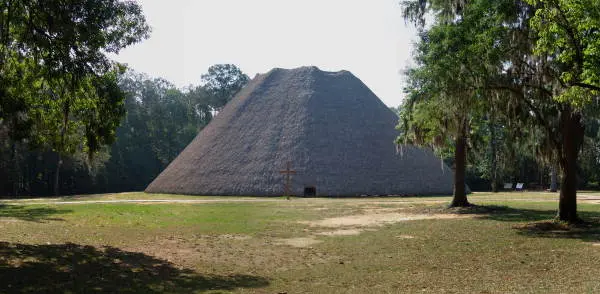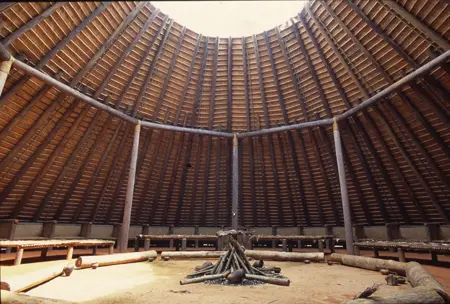The Apalachee tribe lived in Florida’s Panhandle, and by the 1500s they had developed a sophisticated culture with farming villages and ceremonial centers. Anhaica, the Apalachee capital, was located near present day Tallahassee.
The Apalachee were part of an extensive trade network that extended north to the Great Lakes and west to present day Oklahoma. The Florida tribe would trade shells, shark’s teeth, and smoked fish for copper, mica, and other minerals not found in their native land.
“They were known by Indian tribes in south Florida and elsewhere as rich and powerful, and a lot of it had to do with the location here in the red hills of Tallahassee,” says Karin Stanford, program supervisor at Mission San Luis Living History Museum.
“The soil is extremely good for growing food. So you had a group of Indians who didn’t have to travel with the game, who could remain in place, and have enough food. In later years when the Spanish were here, they basically kept St. Augustine alive. They were the breadbasket for La Florida. They were also fierce warriors, and they were known for that, too.”
The first contact that the Apalachee had with Europeans came on July 15, 1528, when Spanish conquistador Pánfilo Narváez and his men attempted to overpower the Florida natives. That attack was successfully repelled.
In 1539, Hernando de Soto and his men landed on the Gulf Coast of Florida and traveled through the center of the state, looking for gold and killing any natives they encountered along the way. Hearing that the Apalachee might have gold, the expedition traveled west to Anhaica.
This time, the Spanish were able to capture the Apalachee capital.
The tribe had developed such an effective method of preserving food that they were able to feed de Soto’s 600 men and 220 horses for 5 months. In the spring of 1540, the Spanish moved on, continuing their search for gold in present day Georgia.
In 1633, two friars established the first Catholic missions in Apalachee territory, and Spanish soldiers soon followed. The Apalachee people became citizens of Spain by accepting Christianity.
By 1656, Mission San Luis was established at the seat of Apalachee power, solidifying a religious, military, and economic alliance. In the final decades of the 1600s, Spanish families joined the settlement of 1,400 Apalachee at Mission San Luis.
A Franciscan church and a defensive fort were built to serve both the native and Spanish occupants of San Luis de Talimali. The most impressive structure in the town was the Apalachee Council House.
A reconstruction of the council house is part of the Mission San Luis Living History Museum in Tallahassee.
The Apalachee Council House is a large, round building with a thatched, sloped roof that touches the ground. Sleeping alcoves surrounding the central space allowed the Apalachee Chief to entertain visitors traveling from great distances. An oculus in the ceiling illuminates the interior of the structure. Thousands of people could gather inside.
San Luis de Talimali was named the western capital of Spanish Florida from 1656 to 1704, until the residents decided to burn their settlement to the ground.
By 1702, England and Spain were at war. The English began destroying Catholic missions in Florida as a way of undermining Spanish control. With English forces approaching San Luis de Talimali, the Spanish and the Apalachee evacuated the women and children from their shared settlement.
“They knew the end was near,” says Stanford. “In the spring of 1704, the records show that for the first time in thousands of years, the Apalachee did not plant corn. They knew that they could be here to sew it, but not to reap.”
On July 1, 1704, the Spanish and their Apalachee allies burned down Mission San Luis, to keep it from being captured by the English.
Some of the Apalachee fled to St. Augustine with the Spanish. Others surrendered to the British. Another group traveled west to Pensacola, continued to French controlled Mobile, eventually settling in Louisiana.
The dispersed Apalachee were lost to history until the 1990s, when records uncovered in Rapides Parish, Louisiana, identified a small group of people there as descendants of Apalachee from Florida’s Mission San Luis.

